Force Performance Analysis and Numerical Simulation of Assembled Ribbed-Slab Abutments
Abstract
1. Introduction
2. Static Load Test of Assembled Ribbed-Slab Abutment Model
2.1. Summary of Tests
2.2. Bending Test of Assembled Ribbed-Abutment
2.2.1. Experimental Phenomena
2.2.2. Experimental Results
- (1)
- Crack load
- (2)
- Local ultimate load
- (3)
- Local limit displacement
2.3. Shear Test of Assembled Ribbed-Slab Abutment
Experimental Phenomenon
3. Assembled Ribbed-Slab Abutment Model Validation and Foundation Model Analysis
3.1. Development and Validation of Numerical Analysis Models
3.1.1. FE Simulation of Test Models
3.1.2. Validation of FE Models
- (1)
- Load and displacement conditions
- (2)
- Distribution of cracks
3.2. FE Analysis of the Full Model of the Assembled Ribbed-Abutment
- (1)
- Damage to concrete
- (2)
- Reinforcement Skeleton Equivalent Force Cloud
- (3)
- Stress map of the connector
- (4)
- Load–deflection curve for the midspan section
4. Parametric FE Analysis of Assembled Ribbed-Abutments
4.1. Analysis of the Effect of Stiffening Rib Thickness
4.2. Analysis of the Impact of the Number of Screws
4.3. Analysis of the Length of Flange Anchoring Steel Plate
5. Conclusions
- (1)
- Compared with the cast-in-place bridge abutment model, the ultimate bearing capacity and ultimate deformation capacity of the two types of ARBA were significantly reduced, in which the bearing capacity of the flange-connected ARBA was significantly better than that of the ox-leg bolts, and the bearing capacity of the flange-connected ARBA reached that of the “cast-in-place equivalent.” However, the deformation capacity of the flange connection was slightly weaker than that of the clevis bolts, and the deformation capacity of the two types of ARBA was significantly weaker than that of the cast-in-place bridge abutment.
- (2)
- The flange joint structure is recommended to use the assembly of ribbed-plate bridge deck reasonable joint structure, due to which the performance of the assembly of ribbed-plate bridge deck in the force became “equivalent to that of the cast-in-place,” and later, maintenance was convenient.
- (3)
- Compared with the overall ARBA, under ideal conditions, the ultimate bearing capacity of the ribbed slab abutment could be better than that of the overall cast-in-place ribbed-slab abutment, whereas the ARBA deformation capacity of the structure was relatively weaker than that of the overall cast-in-place ribbed-slab abutment, and the damage to the two structures was the same. When the structure was damaged, the ARBA connection device of the ARBA did not reach the yield state.
- (4)
- Based on a comparative analysis of the ARBA connecting device, its stiffening rib thickness, the number of bolts, and the length of flange plate anchoring steel plate under different working conditions, the comprehensive consideration of the economy, structural stress performance, and other factors, the following combination of the parameters are recommended: the thickness of the stiffening rib is 30 mm, the number of bolts is 12, and a length of 50 cm of the length of flange plate anchoring steel plate.
Author Contributions
Funding
Institutional Review Board Statement
Informed Consent Statement
Data Availability Statement
Conflicts of Interest
References
- Zhang, J.; Tao, F.; Su, T. Research on assembly building integration system based on BIM technology. Build. Sci. 2018, 34, 97–102+129. [Google Scholar]
- Xue, L. Research on the Key Technology of Manufacturing Green Composite Concrete Girder Bridge; Northeastern University: Boston, MA, USA, 2016. [Google Scholar]
- Khan, M.A. Accelerated Bridge Construction: Best Practices and Techniques; Butler Worth Heinemann: Oxford, UK, 2014. [Google Scholar]
- Xiang, Y.-Q.; Zhu, S.; Zhao, Y. Research progress of rapid construction bridge. China J. Highw. 2018, 31, 1–27. [Google Scholar]
- Scanlon, A.; Aswad, A.; Stellar, J. Precast Posttensioned Abutment System and Precast Superstructure for Rapid On-Site Construction. Transp. Res. Rec. 2002, 1814, 65–71. [Google Scholar] [CrossRef]
- Zhuo, W.D.; Li, C.C.; Sun, Z.X.; Xiao, Z.R.; Lin, Z.T.; Huang, X.Y. Static performance test of segmentally prefabricated prestressed concrete cover beam. J. Tongji Univ. (Nat. Sci. Ed.) 2022, 50, 1752–1760. [Google Scholar]
- Li, C.; Zhuo, W.; Lin, K.; Sun, Y.; Chen, M. Experimental study on flexural behavior of segmental precast large-cantilevered prestressed concrete cap beam. Structures 2023, 57, 105166. [Google Scholar] [CrossRef]
- Bridge Precast Substructure Units [Z]. 2004 NOVA Award Nomination 14. 2004.
- Stamnas, P.E.; Whittemore, M.D. All Precast Substructure Accelerates Construction of Prestressed Concrete Bridge in New Hampshire. PCI J. 2005, 50, 26–39. [Google Scholar] [CrossRef]
- Guidelines for Accelerated Bridge Construction Using Precast/Prestressed Concrete Components; PCI Northeast: Belmont, MA, USA, 2006.
- Palls, M.L.; Newman, P. Accelerated Bridge Design and Construction around the Country. In Proceedings of the 15th Annual Caltrans/PCMAC Bridge Seminar, Sacramento, CA, USA, 15 October 2008. [Google Scholar]
- Benoit, N.D.; Calderwood, E.T.; Frankhauser, W.L., Jr.; Hanson, D.R.; Heil, K.R.; Tweedie, J.J. Instant Bridge—Just Add Water; Palm Springs, CA, USA, 2005. [Google Scholar]
- Huh, B.P.; Low, J.P. Moose Creek Bridge, the First Field Application of Fully Prefabricated Bridges in Ontario; Atlanta, GA, USA, 2004. [Google Scholar]
- Wolfe, R.W.; Chung, P.; Dermegerdician, A. Accelerating Bridge Construction-Precast Abutment Solutions; Phoenix, AZ, USA, 2007. [Google Scholar]
- Yong, Z.; Rui, L.; Xiaofeng, W.; Chao, H. Experimental study on seismic performance of prefabricated columns with large-diameter high-strength steel bar grouted sleeve connection. China Civ. Eng. J. 2017, 50, 27–35+71. [Google Scholar]
- Crawford, G.A.; Parikh, H.; Thompson, J.A. Accelerated Replacement of a Three Span Bridge in Pennsylvania; Grapevine, TX, USA, 2006. [Google Scholar]
- Bu, Z.; Guo, J.; Zheng, R.; Song, J.; Lee, G.C. Cyclic performance and simplified pushover analyses of precast segmental concrete bridge columns with circular section. Earthq. Eng. Eng. Vib. 2016, 15, 297–312. [Google Scholar] [CrossRef]
- Chen, Y.J.; Ding, M.J.; Xu, W.B.; Wang, J.; Fang, R.; Du, X.L.; Han, Q. Research progress on prefabricated assembled pier system and its seismic performance. China J. Highw. Transp. 2022, 35, 56–76. [Google Scholar]
- Terry, J.; Wipf, F.; Klaiber, W.; Hockewman, S. Precast Concrete Elements for Accelerated Bridge Construction: Laboratory Testing of Precast Substructure Components; Bone Country Bridge [R]; Bridge Engineering Center: Ames, IA, USA, January 2009. [Google Scholar]
- Terry, J.; Wipf, F.; Klaiber, W.; Hockewman, S. Precast Concrete Elements for Accelerated Bridge Construction: Laboratory Testing, Field Testing, Evaluation of a Precast Country Bridge; [R]; Bridge Engineering Center: Ames, IA, USA, January 2009. [Google Scholar]
- He, D. Design Scheme and Finite Element Analysis of Cast-in-Place Assembled Bridge Abutment. Master’s Thesis, Wuhan University of Technology, Wuhan, China, 2011. [Google Scholar]
- Xia, L.; Hu, Z.; Shah, Y.I. Longitudinal load distribution of a weakly connected prefabricated bridge abutment. Arch. Appl. Mech. 2021, 91, 4121–4140. [Google Scholar] [CrossRef]
- JTG D62-2012; Design Specification for Reinforced and Prestressed Concrete Bridges and Culverts for Highways. China Communication Press: Beijing, China, 2012.
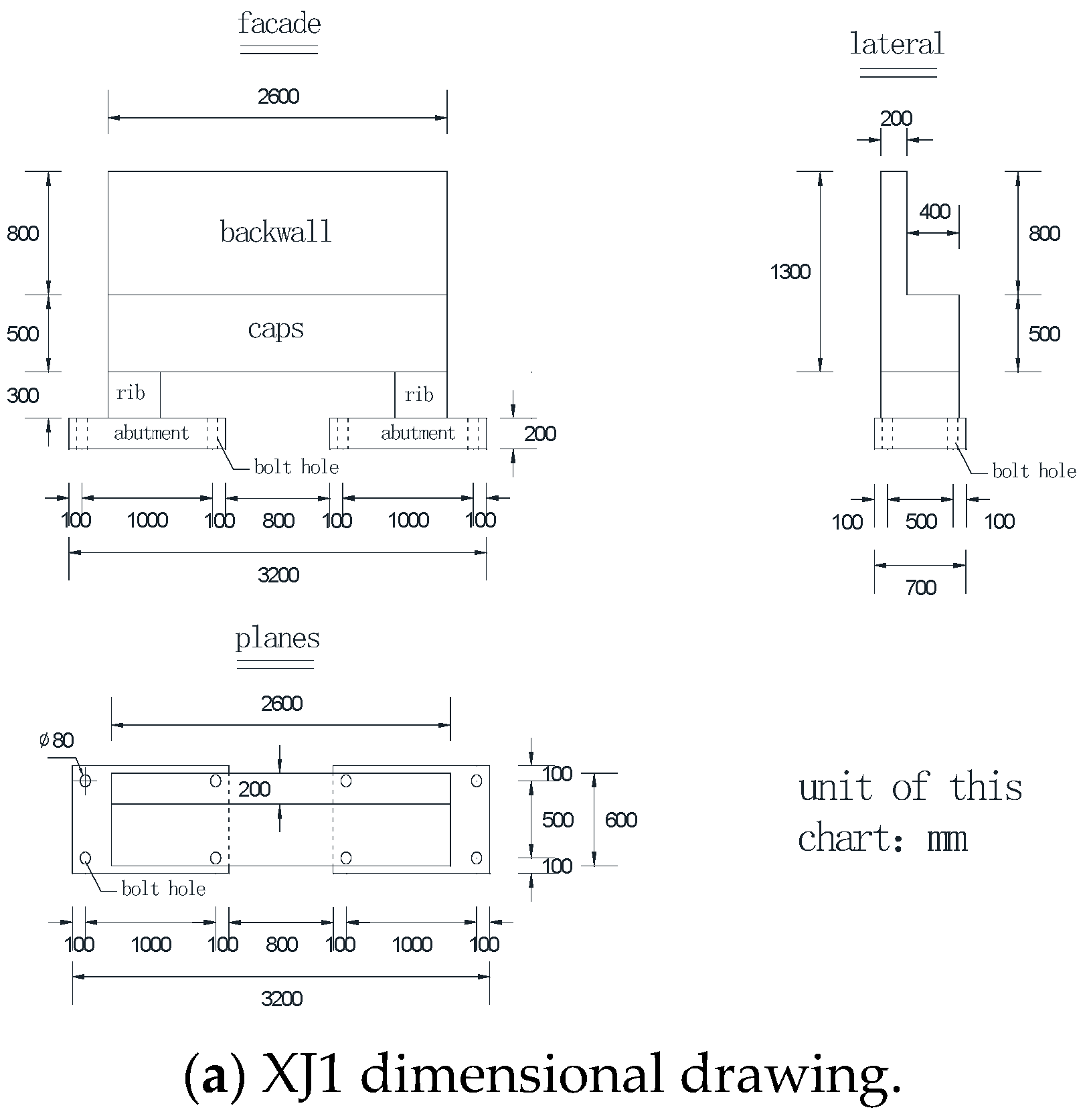


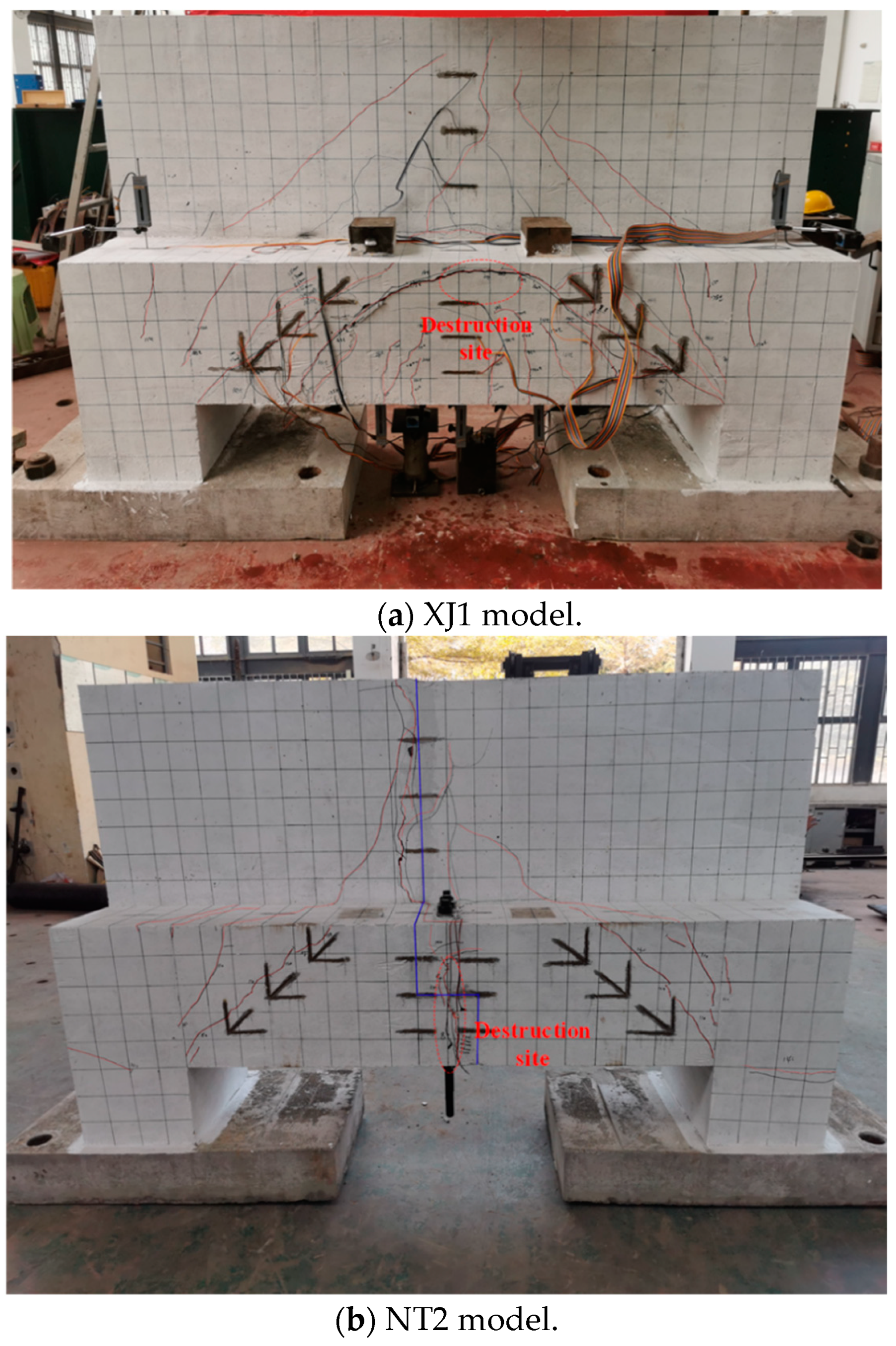
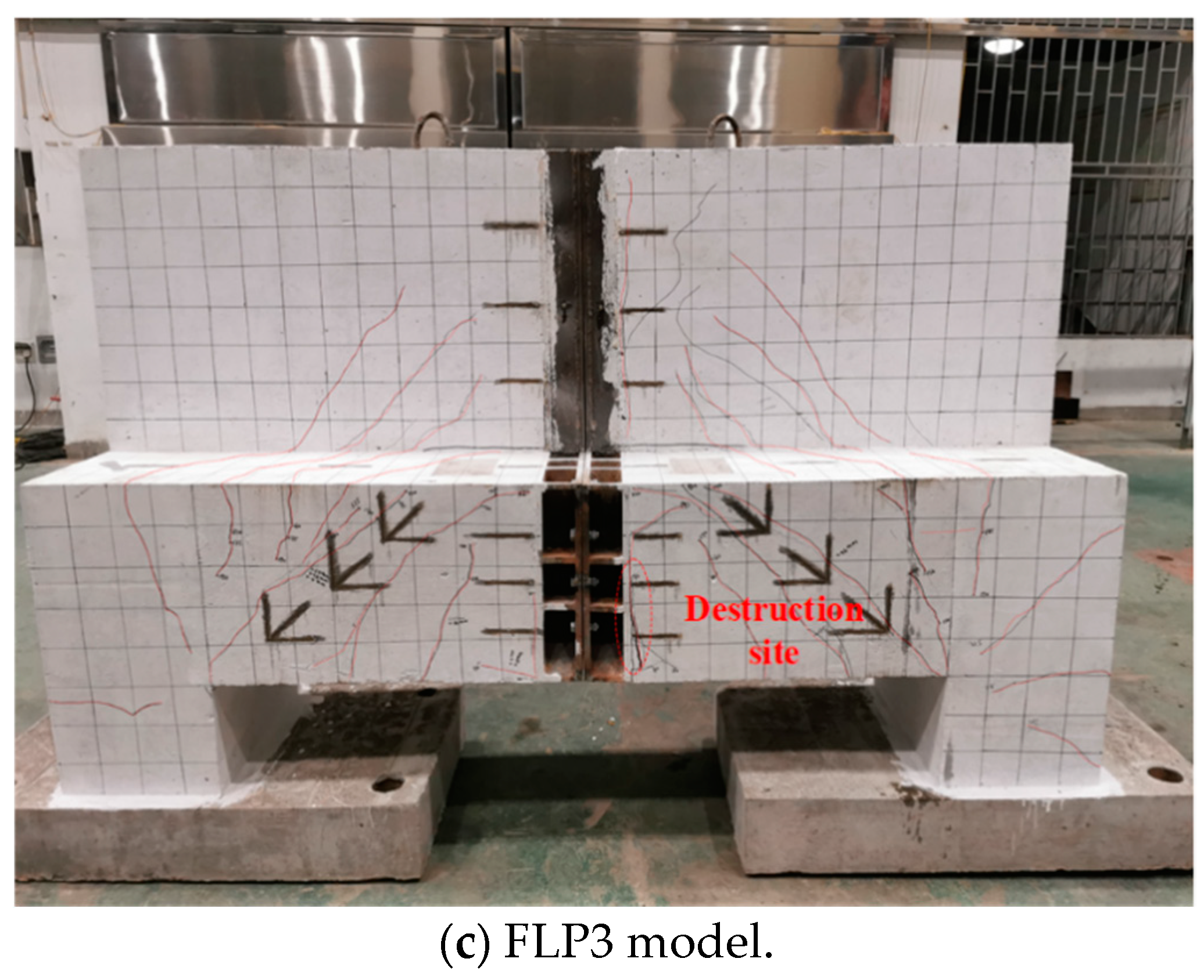


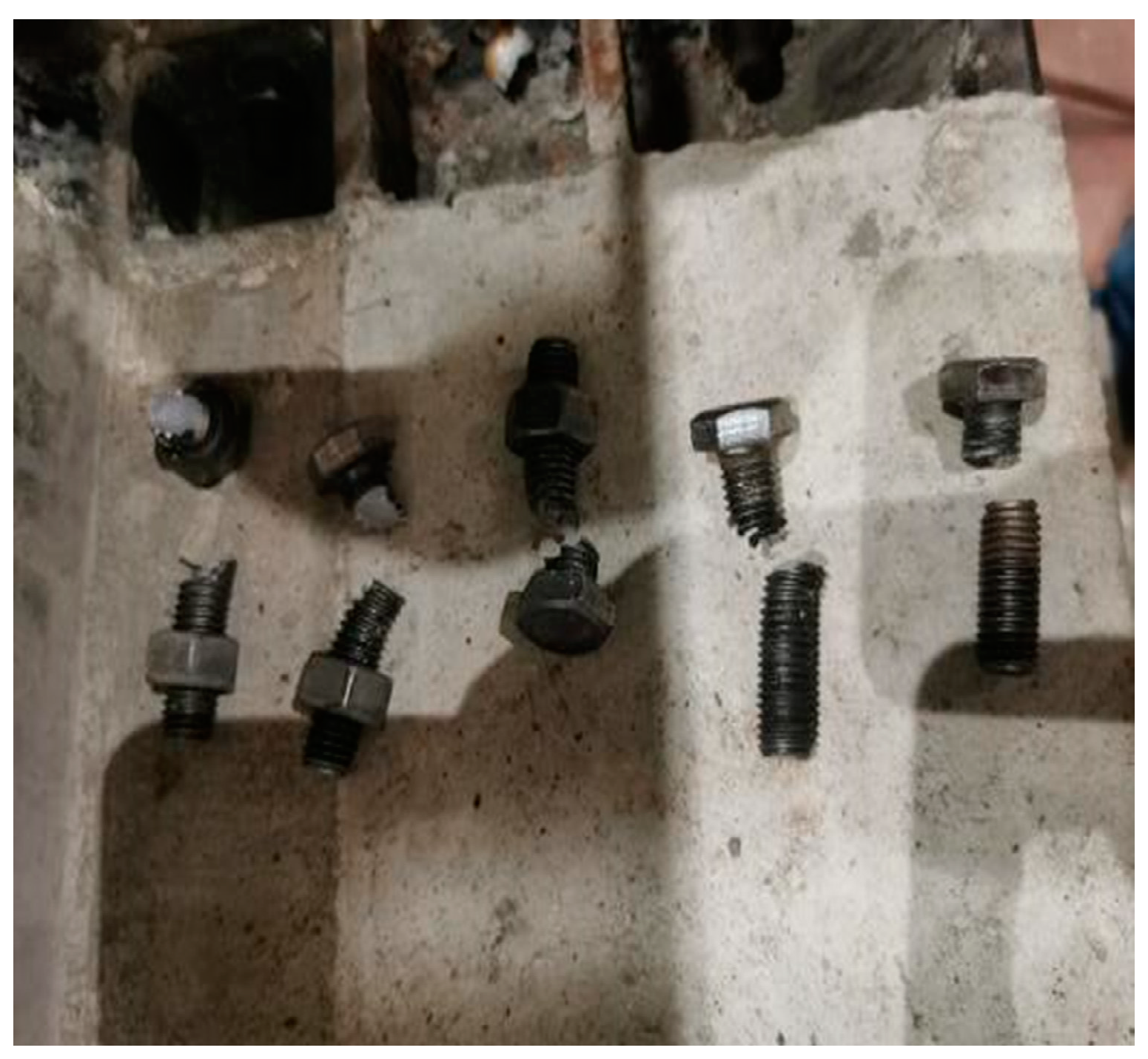


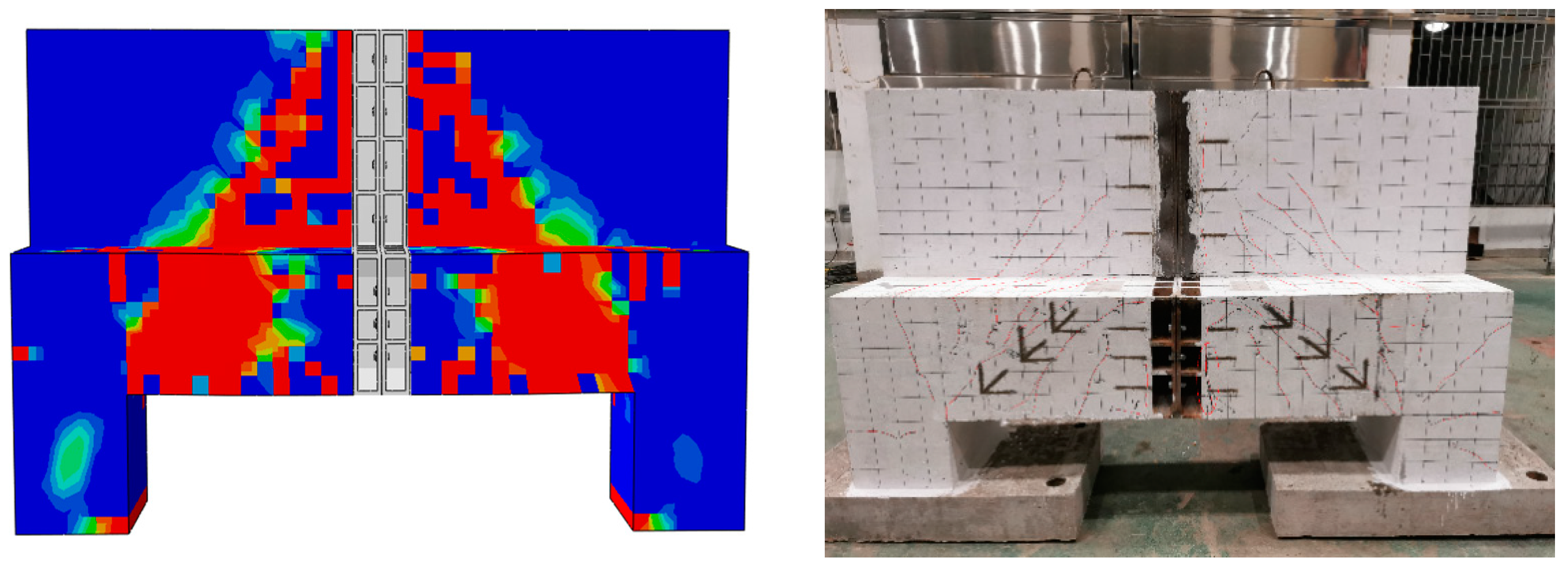
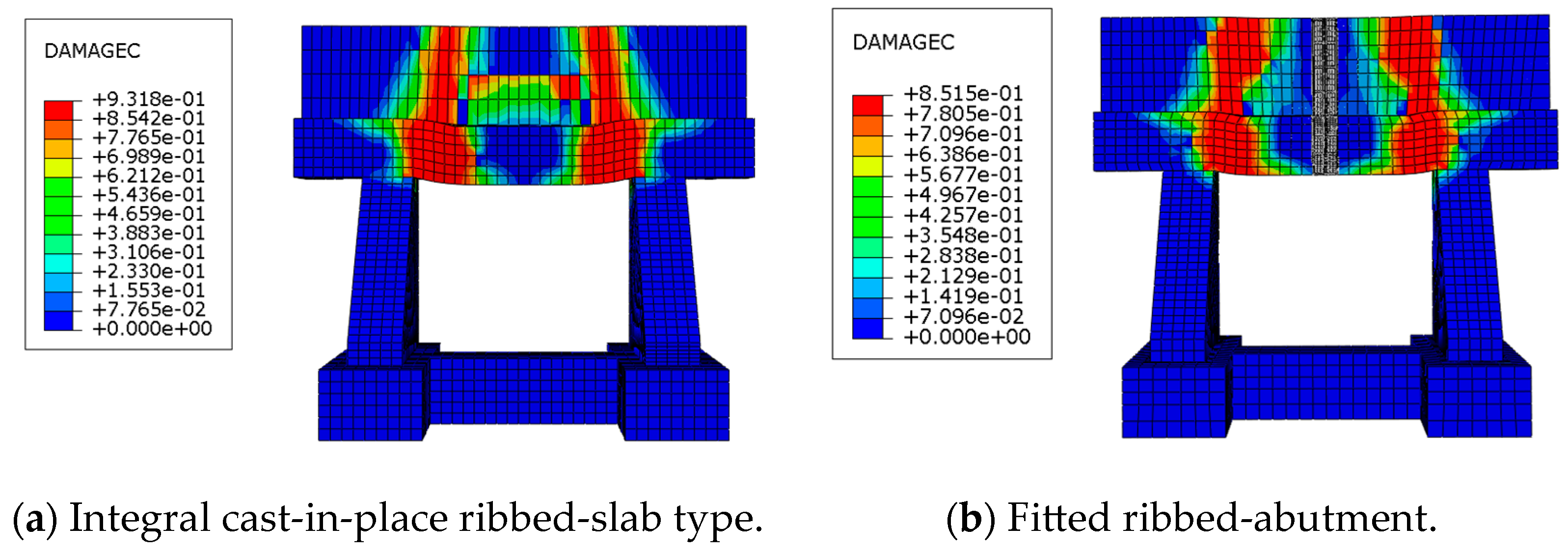

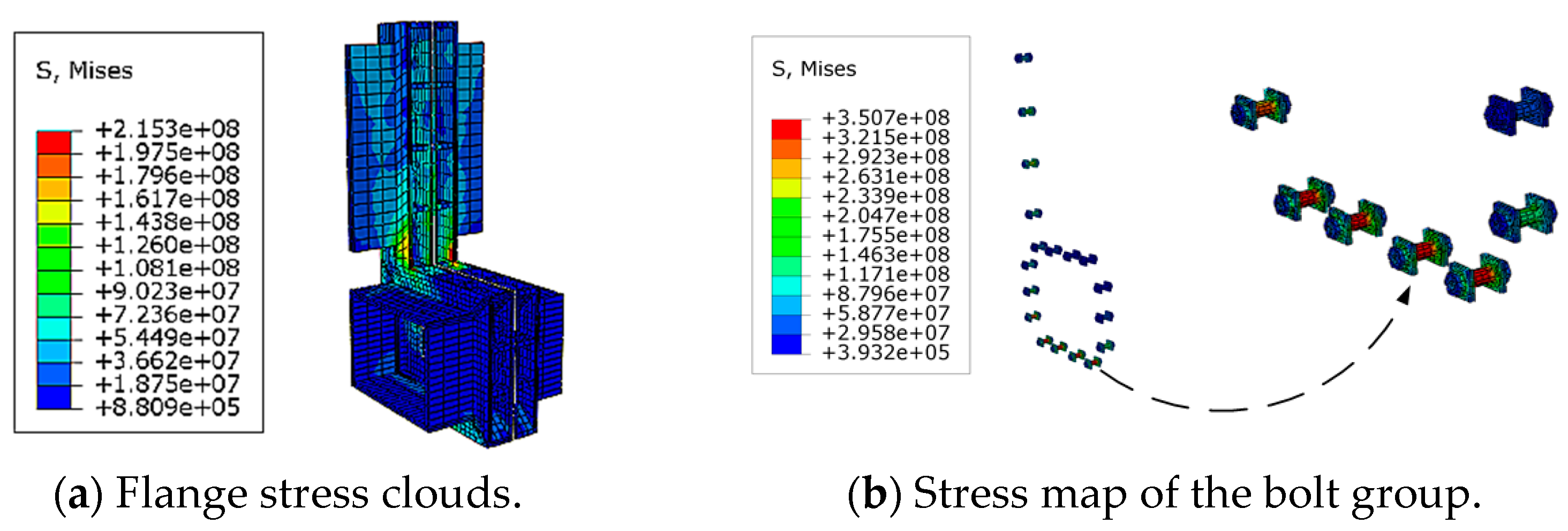
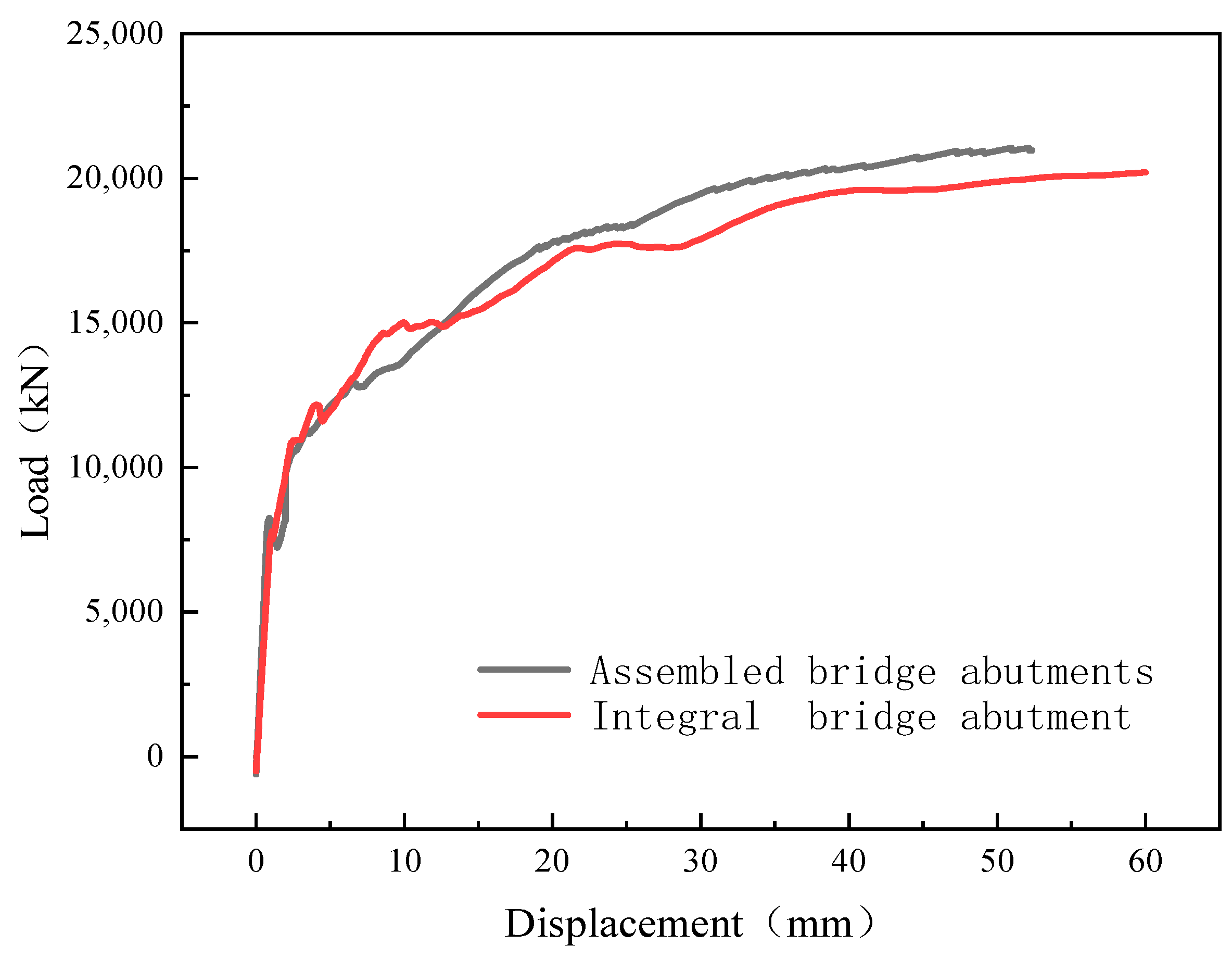

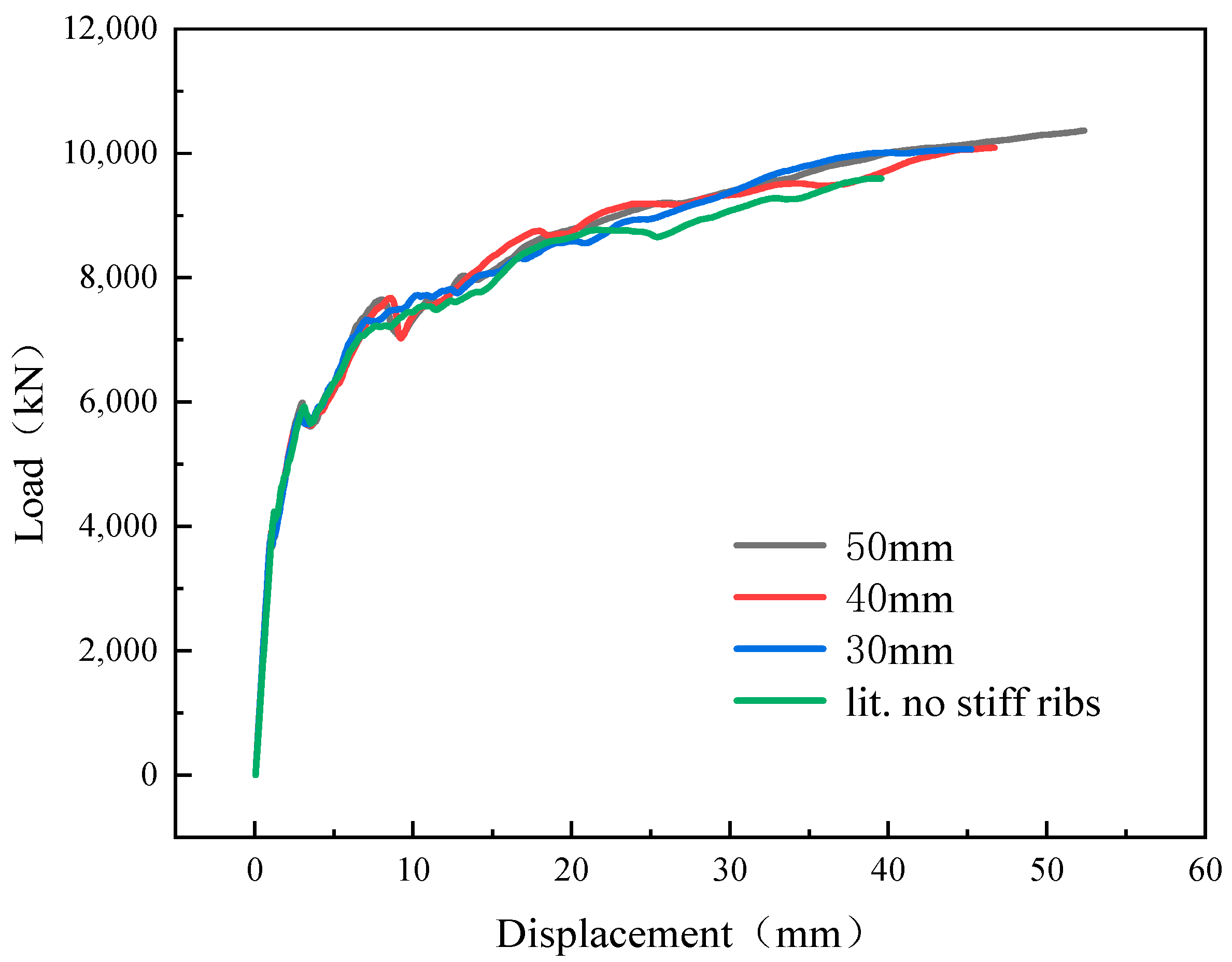
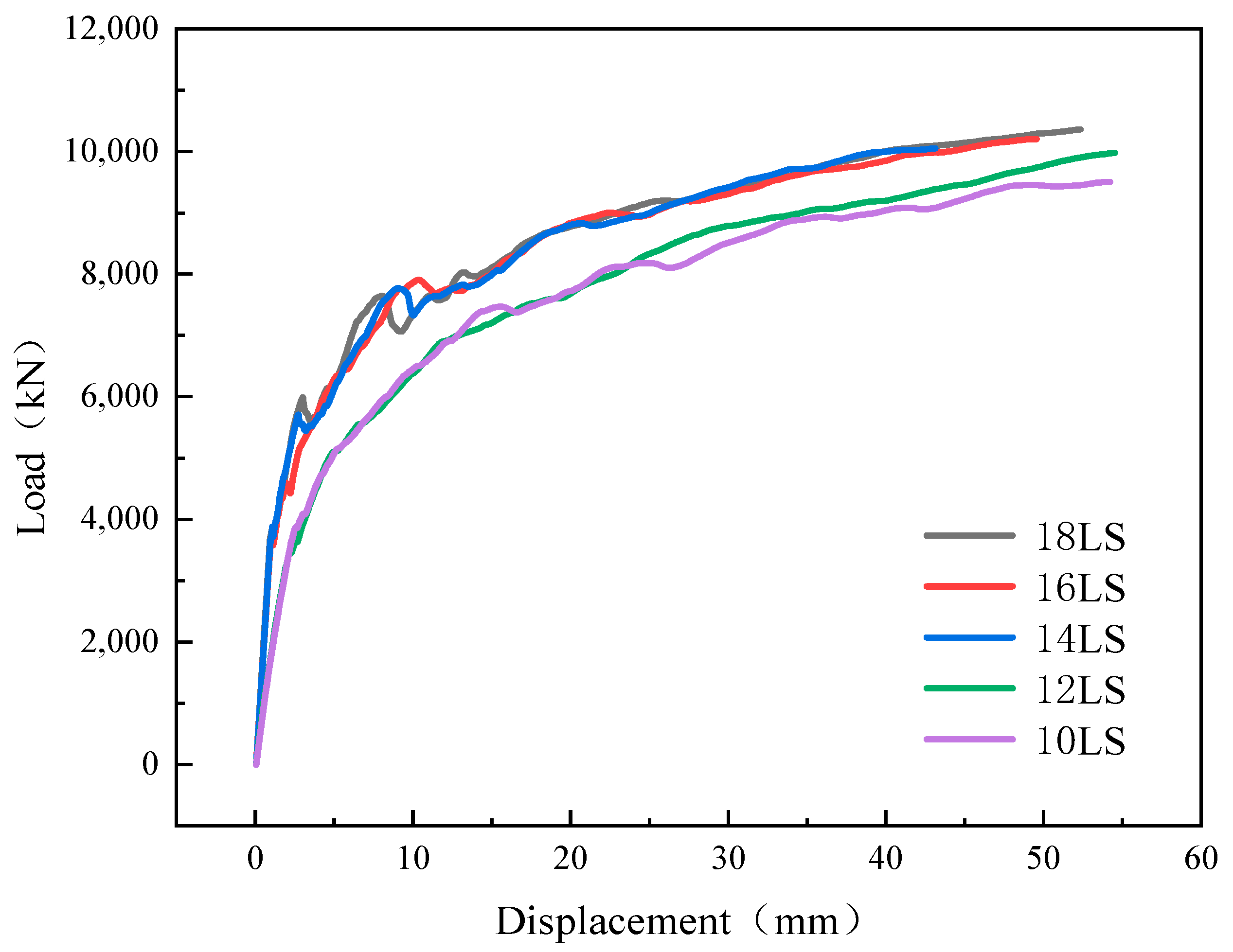

| Model Number | Loading Method | Seam Construction | Ordinary Rebar |
|---|---|---|---|
| XJ1 | Static load test | Monolithic casting | Progression |
| NT2 | Static load test | Bolted joints | Seam break |
| FLP3 | Static load test | Flange connection | Seam break |
| Model Number | Crack Load (kN) | Local Ultimate Load (kN) | Local Limit Displacement (mm) | |||
|---|---|---|---|---|---|---|
| Actual Measured Value | ARBA/XJ | Actual Measured Value | ARBA/XJ | Actual Measured Value | ARBA/XJ | |
| XJ1 | 1200 | 1 | 2350 | 1 | 6.1 | 1 |
| NT2 | 700 | 0.58 | 1500 | 0.6 | 5.1 | 0.84 |
| FLP3 | 800 | 0.67 | 2350 | 1 | 4.9 | 0.49 |
| Expansion Angle | Eccentricity | fb0/fc0 | K | Coefficient of Viscosity |
|---|---|---|---|---|
| 30 | 0.1 | 1.16 | 0.6667 | 0.0005 |
| Part | Materials | Elasticity (MPa) | Yield Strength (MPa) | Tensile Strength (MPa) | Poisson’s Ratio |
|---|---|---|---|---|---|
| Flange plate | Q345 | 2.06 × 10−5 | 350 | 495 | 0.3 |
| rebar | HRB400 | 2.05 × 10−5 | 400 | 540 | 0.3 |
| Bolts, gaskets | 4.8 steel | 2.00 × 10−5 | 320 | 400 | 0.3 |
| Model | Test Model | FE Model | Tolerance (%) |
|---|---|---|---|
| Cracking load (kN) | 800 | 816 | 2 |
| Ultimate load (kN) | 2350 | 2471 | 5 |
| Limit displacement (mm) | 4.9 | 5.1 | 4 |
| Number of Bolts (pcs) | Individual Shear Strength (kN) | Total Shear Strength (kN) | Modeled Mid-Span Section Shear Capacity (kN) |
|---|---|---|---|
| 10 | 592 | 5920 | 6073.83 |
| 12 | 7140 | ||
| 14 | 8288 | ||
| 16 | 9472 | ||
| 18 | 10,656 |
Disclaimer/Publisher’s Note: The statements, opinions and data contained in all publications are solely those of the individual author(s) and contributor(s) and not of MDPI and/or the editor(s). MDPI and/or the editor(s) disclaim responsibility for any injury to people or property resulting from any ideas, methods, instructions or products referred to in the content. |
© 2024 by the authors. Licensee MDPI, Basel, Switzerland. This article is an open access article distributed under the terms and conditions of the Creative Commons Attribution (CC BY) license (https://creativecommons.org/licenses/by/4.0/).
Share and Cite
He, Q.; Sun, Y.; Gu, Y.; Wu, T. Force Performance Analysis and Numerical Simulation of Assembled Ribbed-Slab Abutments. Appl. Sci. 2024, 14, 3224. https://doi.org/10.3390/app14083224
He Q, Sun Y, Gu Y, Wu T. Force Performance Analysis and Numerical Simulation of Assembled Ribbed-Slab Abutments. Applied Sciences. 2024; 14(8):3224. https://doi.org/10.3390/app14083224
Chicago/Turabian StyleHe, Qiaozhu, Ying Sun, Yin Gu, and Tong Wu. 2024. "Force Performance Analysis and Numerical Simulation of Assembled Ribbed-Slab Abutments" Applied Sciences 14, no. 8: 3224. https://doi.org/10.3390/app14083224
APA StyleHe, Q., Sun, Y., Gu, Y., & Wu, T. (2024). Force Performance Analysis and Numerical Simulation of Assembled Ribbed-Slab Abutments. Applied Sciences, 14(8), 3224. https://doi.org/10.3390/app14083224







